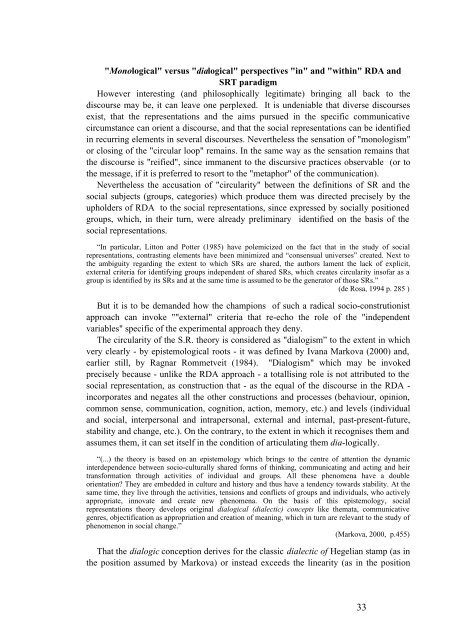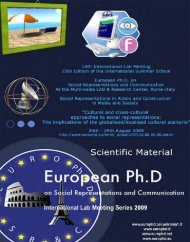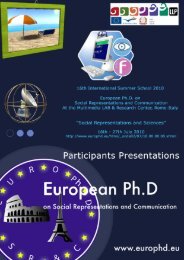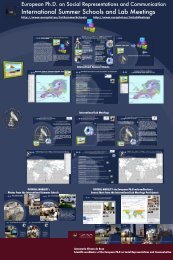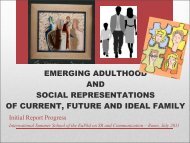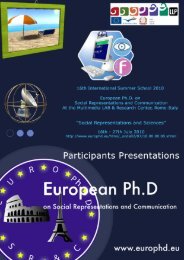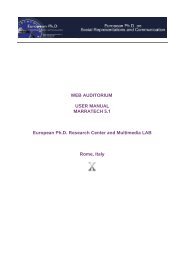The "boomerang" effect of the radicalism in discourse analysis
The "boomerang" effect of the radicalism in discourse analysis
The "boomerang" effect of the radicalism in discourse analysis
Create successful ePaper yourself
Turn your PDF publications into a flip-book with our unique Google optimized e-Paper software.
"Monological" versus "dialogical" perspectives "<strong>in</strong>" and "with<strong>in</strong>" RDA and<br />
SRT paradigm<br />
However <strong>in</strong>terest<strong>in</strong>g (and philosophically legitimate) br<strong>in</strong>g<strong>in</strong>g all back to <strong>the</strong><br />
<strong>discourse</strong> may be, it can leave one perplexed. It is undeniable that diverse <strong>discourse</strong>s<br />
exist, that <strong>the</strong> representations and <strong>the</strong> aims pursued <strong>in</strong> <strong>the</strong> specific communicative<br />
circumstance can orient a <strong>discourse</strong>, and that <strong>the</strong> social representations can be identified<br />
<strong>in</strong> recurr<strong>in</strong>g elements <strong>in</strong> several <strong>discourse</strong>s. Never<strong>the</strong>less <strong>the</strong> sensation <strong>of</strong> "monologism"<br />
or clos<strong>in</strong>g <strong>of</strong> <strong>the</strong> "circular loop" rema<strong>in</strong>s. In <strong>the</strong> same way as <strong>the</strong> sensation rema<strong>in</strong>s that<br />
<strong>the</strong> <strong>discourse</strong> is "reified", s<strong>in</strong>ce immanent to <strong>the</strong> discursive practices observable (or to<br />
<strong>the</strong> message, if it is preferred to resort to <strong>the</strong> "metaphor" <strong>of</strong> <strong>the</strong> communication).<br />
Never<strong>the</strong>less <strong>the</strong> accusation <strong>of</strong> "circularity" between <strong>the</strong> def<strong>in</strong>itions <strong>of</strong> SR and <strong>the</strong><br />
social subjects (groups, categories) which produce <strong>the</strong>m was directed precisely by <strong>the</strong><br />
upholders <strong>of</strong> RDA to <strong>the</strong> social representations, s<strong>in</strong>ce expressed by socially positioned<br />
groups, which, <strong>in</strong> <strong>the</strong>ir turn, were already prelim<strong>in</strong>ary identified on <strong>the</strong> basis <strong>of</strong> <strong>the</strong><br />
social representations.<br />
“In particular, Litton and Potter (1985) have polemicized on <strong>the</strong> fact that <strong>in</strong> <strong>the</strong> study <strong>of</strong> social<br />
representations, contrast<strong>in</strong>g elements have been m<strong>in</strong>imized and “consensual universes” created. Next to<br />
<strong>the</strong> ambiguity regard<strong>in</strong>g <strong>the</strong> extent to which SRs are shared, <strong>the</strong> authors lament <strong>the</strong> lack <strong>of</strong> explicit,<br />
external criteria for identify<strong>in</strong>g groups <strong>in</strong>dependent <strong>of</strong> shared SRs, which creates circularity <strong>in</strong>s<strong>of</strong>ar as a<br />
group is identified by its SRs and at <strong>the</strong> same time is assumed to be <strong>the</strong> generator <strong>of</strong> those SRs.”<br />
(de Rosa, 1994 p. 285 )<br />
But it is to be demanded how <strong>the</strong> champions <strong>of</strong> such a radical socio-construtionist<br />
approach can <strong>in</strong>voke ""external" criteria that re-echo <strong>the</strong> role <strong>of</strong> <strong>the</strong> "<strong>in</strong>dependent<br />
variables" specific <strong>of</strong> <strong>the</strong> experimental approach <strong>the</strong>y deny.<br />
<strong>The</strong> circularity <strong>of</strong> <strong>the</strong> S.R. <strong>the</strong>ory is considered as "dialogism” to <strong>the</strong> extent <strong>in</strong> which<br />
very clearly - by epistemological roots - it was def<strong>in</strong>ed by Ivana Markova (2000) and,<br />
earlier still, by Ragnar Rommetveit (1984). "Dialogism" which may be <strong>in</strong>voked<br />
precisely because - unlike <strong>the</strong> RDA approach - a totallis<strong>in</strong>g role is not attributed to <strong>the</strong><br />
social representation, as construction that - as <strong>the</strong> equal <strong>of</strong> <strong>the</strong> <strong>discourse</strong> <strong>in</strong> <strong>the</strong> RDA -<br />
<strong>in</strong>corporates and negates all <strong>the</strong> o<strong>the</strong>r constructions and processes (behaviour, op<strong>in</strong>ion,<br />
common sense, communication, cognition, action, memory, etc.) and levels (<strong>in</strong>dividual<br />
and social, <strong>in</strong>terpersonal and <strong>in</strong>trapersonal, external and <strong>in</strong>ternal, past-present-future,<br />
stability and change, etc.). On <strong>the</strong> contrary, to <strong>the</strong> extent <strong>in</strong> which it recognises <strong>the</strong>m and<br />
assumes <strong>the</strong>m, it can set itself <strong>in</strong> <strong>the</strong> condition <strong>of</strong> articulat<strong>in</strong>g <strong>the</strong>m dia-logically.<br />
“(...) <strong>the</strong> <strong>the</strong>ory is based on an epistemology which br<strong>in</strong>gs to <strong>the</strong> centre <strong>of</strong> attention <strong>the</strong> dynamic<br />
<strong>in</strong>terdependence between socio-culturally shared forms <strong>of</strong> th<strong>in</strong>k<strong>in</strong>g, communicat<strong>in</strong>g and act<strong>in</strong>g and heir<br />
transformation through activities <strong>of</strong> <strong>in</strong>dividual and groups. All <strong>the</strong>se phenomena have a double<br />
orientation? <strong>The</strong>y are embedded <strong>in</strong> culture and history and thus have a tendency towards stability. At <strong>the</strong><br />
same time, <strong>the</strong>y live through <strong>the</strong> activities, tensions and conflicts <strong>of</strong> groups and <strong>in</strong>dividuals, who actively<br />
appropriate, <strong>in</strong>novate and create new phenomena. On <strong>the</strong> basis <strong>of</strong> this epistemology, social<br />
representations <strong>the</strong>ory develops orig<strong>in</strong>al dialogical (dialectic) concepts like <strong>the</strong>mata, communicative<br />
genres, objectification as appropriation and creation <strong>of</strong> mean<strong>in</strong>g, which <strong>in</strong> turn are relevant to <strong>the</strong> study <strong>of</strong><br />
phenomenon <strong>in</strong> social change.”<br />
(Markova, 2000, p.455)<br />
That <strong>the</strong> dialogic conception derives for <strong>the</strong> classic dialectic <strong>of</strong> Hegelian stamp (as <strong>in</strong><br />
<strong>the</strong> position assumed by Markova) or <strong>in</strong>stead exceeds <strong>the</strong> l<strong>in</strong>earity (as <strong>in</strong> <strong>the</strong> position<br />
33


